Developing the "Adult" Leader
Peter A.C. Smith, President, TLA Inc.
Published by The Leadership Alliance Inc., October 2000, All Rights ReservedReproduction in whole or in part is strictly forbidden without the Publisher's consent
Introduction
Corporate leadership is in crisis, and unfortunately the symptoms are all too familiar. Who among us hasn't complained often, if not loudly: "The problem round here is a lack of leadership"? And this situation will not improve according to some thirty world-authorities on leadership who advanced a somber view of current leadership potential again and again in "The Leader of the Future"(1). James Bolt's remarks are typical: "The dearth of leadership is apparent throughout society"; and "At a time when leadership is more crucial than ever to our very survival, there is a severe shortage of people to lead corporations into the next century". Unfortunately all but a few of these contributors advance nothing but tautologies, saying in effect "We need more leadership so let's display more leadership". That their approaches haven't worked before and won't work now or in the future seems to have been overlooked.
In his forward to (1) Drucker says "The lessons are unambiguous. The first is that there may be 'born leaders', but there are surely too few to depend on them". I believe that Drucker is right and that Porras and Collins (2) have the answer: leaders for our current and future business climate need not be high charisma individuals who create followers through personal magnetism; they are people who have developed the skills to confront and challenge old patterns, and spearhead new ones, at any level in the organization.
This last proviso is very significant in my opinion, since I believe chances for market success and long-term organizational viability are considerably improved when all personnel in an organization express leadership in their everyday activities. Indeed, I would go further and assert that no organization can expect to survive for long by limiting the exercise of leadership solely to its designated leaders. A variety of successful leadership development initiatives I have been involved with, including the recent highly successful company-wide leadership development program carried out for CN Rail (3), were based on this premise. However, the greater part of this paper deals with the development of leadership at senior organizational levels i.e. leadership for leaders. The development of leadership at other organizational levels involves an extension of the senior level approach in concert with a redesign of relevant meta-competencies. This is described in the section dealing with “Leadership at every level of an organization”.
Important leadership topics treated in the following sections include:
- The impact of current and future business contexts on the organization and its leaders
- The relationship between managing and leading
- The role of the leader
- The skills that exemplary leaders might employ as they attempt to successfully discharge this role
- Leadership at every level of an organization
- The fundamentals of a truly cost-effective approach to the development of leadership capabilities
The Impact Of Current And Future Business Contexts On The Organization And Its Leaders
Not too long ago, change occurred incrementally and infrequently, and organizations operated in environments which were largely characterized by their stability; the motto was "If it ain't broke don't fix it". The challenges we face now and in the future are very different. Figure 1 indicates how a legion of complex interacting factors impacts organizations continuously and rapidly, giving rise to conditions that exhibit patterns, but that are impossible to predict i.e. chaos.
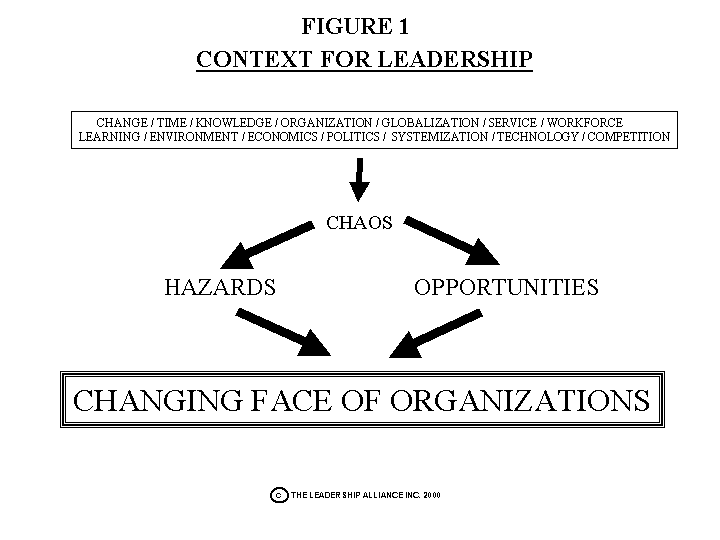
Chaos is both good news and bad news, opportunity and hazard, as Figure 1 indicates. In Conner's opinion (4) "For the leader what is paramount is whether the organization can sustain in the future an unending avalanche of dramatic, overlapping alterations in its key success factors". To remain viable in this dynamic ambiguous environment, organizations have begun to change the way they plan and operate. First organizations plan to undergo only a given degree of turbulence. They do this by segregating and weighing opportunities, targeting subsets of potential markets after giving due consideration to the core capabilities they possess, and the success factors demanded. These new ways of planning and operating form a spectrum of approaches from the past to the present and into the foreseeable future as illustrated in Figure 2.
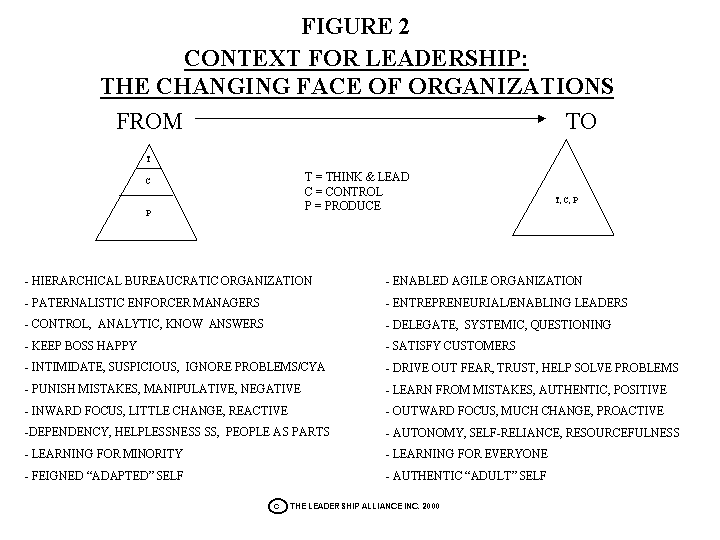
This spectrum is typically considered a journey from the left to the right of the Figure, without any real deadline being set for its completion. Most organizations are still operating in the middle part of this spectrum, with some initiatives further to the right and some still reflecting past ideas. In general, consultants and other authorities recommend adopting an organizational approach at the right-hand end of the spectrum, in order that the enterprise remains viable now and in the future. An anecdote described by Ulrich (1) sums up rather well the view of such authorities. In this story, two individuals want to cross a river. The first person carefully identifies where to cross and then identifies each stone to step in order to reach the other side at the chosen point. The other individual identifies in general where to come out on the other side of the river, finds a few stones to start with, and then gets going. The second individual represents the viable organization of the future in the opinion of most authorities. In any event, it is clear that the organization's current and anticipated future manner of operation will have a large impact on the kind of leadership that will be most successful in operationalizing and sustaining the organization.
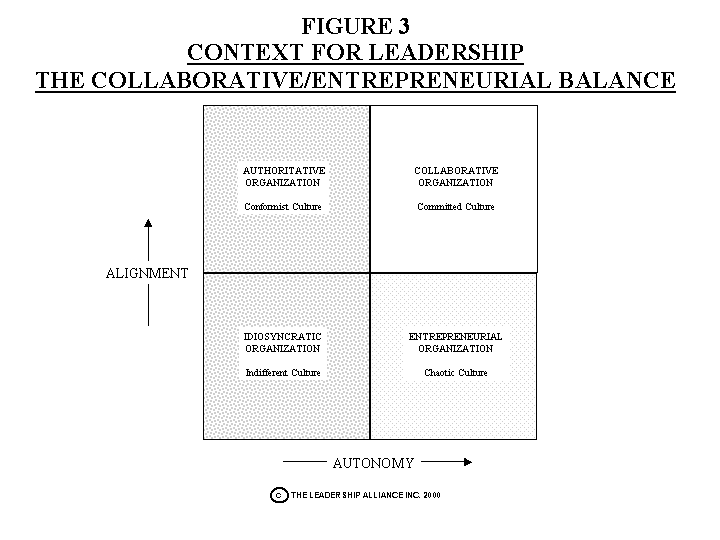
A critical consideration for organizations at different places along the spectrum concerns the extent to which organizational alignment and individual autonomy must be balanced to fit with, and support, the organization's current approach. The various major possibilities are represented in Figure 3. The kind of collaborative organization portrayed at the right hand side of the spectrum in Figure 2 depends largely on high-alignment/high-autonomy
In addition to maintaining high-autonomy/high-alignment, organizations also need to maintain some degree of moderate-alignment/high-autonomy. This is because the entrepreneurial environment represented by this combination confers innovation and creativity that prevent stagnation in the organization, and regression into low-autonomy. Maintaining the appropriate balances is an important element in the role of the organization’s designated leaders.
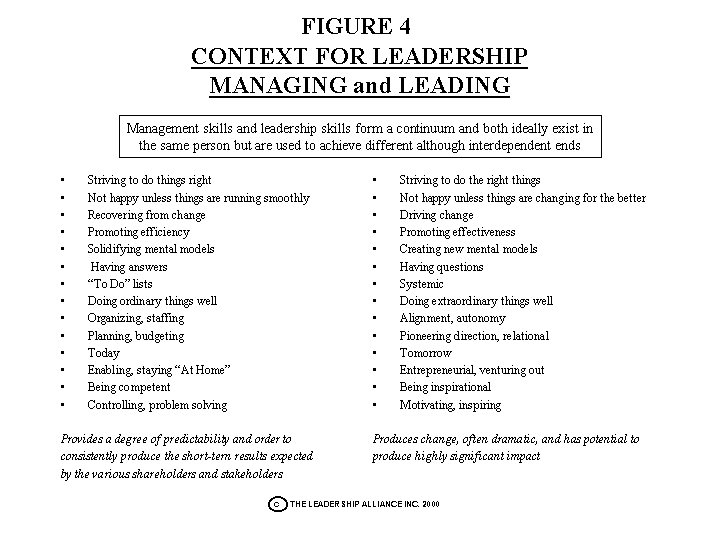
The Relationship Between Managing And Leading
Figure 4 sets out some of the differences between managers and leaders. This is not to say that leaders may not be good managers, but that leadership is something else again. Drucker, Bennis and many other authorities have declared that the difference between leadership and management is that managers deal in efficiency and leaders in effectiveness. If as Hickman suggests (8) managers are satisfied when things go smoothly, and leaders are dissatisfied when things don't change for the better, then we have a "catch twenty-two" situation: as the ratio of managers to leaders increases, there will be increasing resistance to change and the development of the leaders who call for it, leading to an ever deepening crisis in leadership and its development! Indeed Slater (9) quotes Jack Welch as saying he detests the very notion of management. According to Slater, Welch insists that most managers overmanage, with the result that they all too often help to create the bureaucratic sloth and sluggishness that large companies should avoid.
That said, by differentiating management from leadership, I do not mean to imply that one or the other be ignored or is redundant. Rather I believe that by recognizing the important differences between them, an individual is better able to exercise them appropriately in a given situation, and meld them seamlessly in their organizational behaviour. From the characterizations presented in Figure 4, it is reasonable to assume that in more junior organizational positions there will be a tendency to emphasize management behaviours; as individuals rise to executive levels they will tend to employ more of the leadership behaviours. This does not preclude all employees exercising appropriate leadership behaviours as conditions warrant.
It has become clear in leading collaborative organizations of the kind portrayed in Figures 2 and 3, that leaders must more and more become implementers; or perhaps more properly become "enablers". Peter Senge catches the spirit of this concept best when he says "Leaders must sanction significant practical experiments and lead through active participation in those experiments" (1). Other authorities (1) such as Ulrich and Blanchard echo these same ideas, and Blanchard writes "Leadership in the future must involve both vision and implementation".
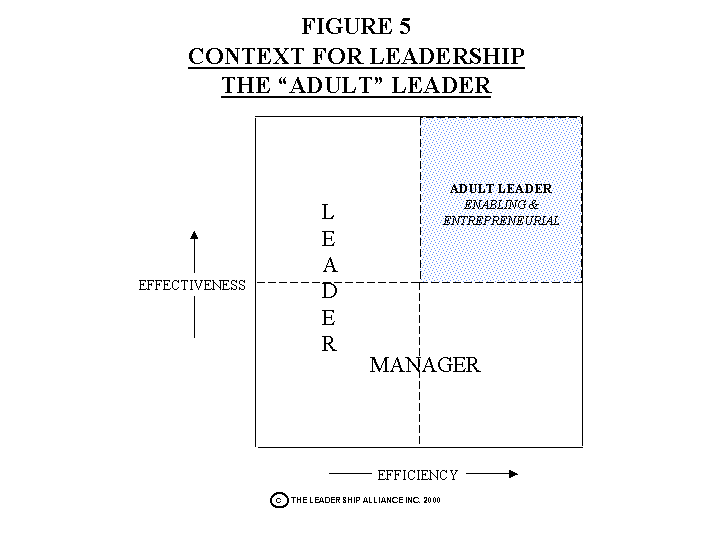
This notion of combining high efficiency with high effectiveness is illustrated in Figure 5. A leader operating in this fashion I term an "Adult Leader". It should be noted that an Adult Leader will be very capable of straddling the collaborative-entrepreneurial border depicted in Figure 3, and of maintaining the dynamic formative/normative balance so essential to an organization's long-term viability (10).
The Role Of The Adult Leader
The generic elements that make up the role of the Adult Leader fall into four important categories:
- Collaborate in strategy formulation
- Co-develop plans to support business strategy implementation
- Lead individuals and teams in implementing plans
- Ensure continuous improvement
Typically, details of the role are tailored to meet the needs of a given organization as discussed in previous sections; however, the categories will likely remain the same. As discussed in the previous section this role ensures that effectiveness and efficiency are appropriately balanced. As Kouzes and Posner (11) recommend, this role also ensures that the Adult Leader " ... enacts the meaning of the organization in every decision that (s)he makes and in every step that (s)he takes toward the future they envision".
Defining and reaching consensus on the elements of the role is easy for most organizations; carrying out the role is hard - very hard. But it is achievable; this generic role with some minor changes formed the basis for the leadership role adopted at a number of companies. For example, it provided a clear sound framework for the successful development of enhanced leadership capability across CN Rail (3). Given that discharging the Adult Leader role adequately is the hard part, in the following sections I will address at some length the skills and development approach necessary to actualize it.
Skills to Discharge the Adult Leader Role Successfully
In spite of a notable lack of success in developing leaders, universally applicable lists of desirable leadership attributes and beneficial psychological leadership profiles continue to be identified ad nausea (12,13). However, very many current authorities agree with Drucker (1) who cautions us not to assume we can define some generic leadership personality, leadership style, or even that universal leadership traits exist. Schein (1) also counsels that the spectrum of organizations need different leaders, so that a we need a unique mix of different people who lead in different ways. He goes on to say "....what leadership should be depends on the particular situation, the task to be performed, and the characteristics of the leader's subordinates". This is consistent with the view I advanced in section one of this paper.
The skills required to successfully discharge the leadership role outlined in the previous section certainly can't simply be extrapolated from past. As Handy points out (1) "A career is now not so much a ladder of roles, but a growing reputation for making things happen. Influence, not authority, is what drives the political organization today in all organizations". Hegelsen (1) describes the new leader similarly as one who has " ... a deep knowledge of his company, his thinking about it has a philosophical cast, and he influences those around him to work in more powerful and innovative ways. Because he has had direct working experience with so many people in the company over the years, he knows their abilities, and he uses this knowledge to direct resources where they are needed. He is a facilitator of power who helps to determine how work actually gets done". Lipman-Blumen (14) goes even further, believing we have now entered what she calls "The Connective Era" where leaders must emphasize mutuality (common interests and values) and inclusiveness (inclusion of non-traditionals without requiring homogenization). There is evidence for this all around us, and it will call for even more emphasis on the development of new and work-relevant leadership qualities.
Lipman-Blumen's point about "inclusiveness" reflects the growing and pressing leadership responsibility related to the increasingly diverse work force (15). This issue not only includes traditional minorities grouped by ethnicity or sex, but also increasingly mixed generational levels in an organizational population. For example, many organizations have a mix of pre-boomers, boomers, Xers, and generation Y; a difficult mix to lead. Good leaders must be able to see talent and skills in all the diverse individuals and groups that comprise their current workforce, and be able to leverage these resources. The three key ingredients for sustained leadership in general, namely challenge, recognition and support, are also critical to promoting the upward mobility of non-traditional managers i.e. promoting diversity at high levels. There is clearly need to retain all the organization's high-potential managers but in particular high potential non-traditional managers since "Diversity is needed at the top of organizations just as much as it is needed at lower levels. One can argue that diversity at the leadership level is necessary to achieve diversity throughout an organization" (15).
Finally, developing and demonstrating "adult" traits as opposed to the any of the "critical, nurturing, adapted, magical" traits described in the pop psychological literature. An important aspect of this "adult" approach is that Adult Leaders believe it's 'OK' to ask questions. Peter Drucker in an address to the Drucker Foundation Advisory Board in 1993 said "The leader of the past was a person who knew how to tell. The leader of the future will be a person who knows how to ask". Wheatley perhaps best sums up this aspect (16) when she writes "In our past explorations, the tradition was to discover something and then formulate it into answers and solutions that could be widely transferred. But now we are on a journey of mutual and simultaneous exploration. In my view all we can expect from one another is new and interesting information. We can not expect answers".
Based on the above, the agenda of leadership skills to successfully discharge the leadership role described in the previous section is a very tall order. A list of important skills would surely include the following:
- Identify and implement current organizational strategies whilst designing the future
- Get things done within the organization's cultural and political norms through organizational "savvy"
- Make decisions and act in today's shorter and shorter business time frames
- Contribute to organizational learning by confronting old patterns and spearheading new ones
- Differentiate puzzles (having an answer) from labyrinthine problems (having many answers), identify the critical problems, ask the right questions and forge innovative solutions
- Act ethically and with courage in conditions of ambiguity, complexity and risk
- Develop and contextualize many sources of information and contribute to effective organizational knowledge management
- Self-develop through local and global business and social experience
- Act in concert with others, and alone as appropriate
- Leverage one's own non-traditional capabilities and those of others
- Communicate via traditional and emerging technological means and build and utilize networks
- Humanize the organization and strengthen "heart" by setting high values and modeling them
In the final section of this paper I will describe how such an awesome list of characteristics can be developed successfully and cost-effectively. However, in the next section I will explore how Adult Leadership can be generalized to all levels of an organization, not just its designated leaders.
Leadership At Every Level Of An Organization
My notion that it is desirable to have leadership displayed at all levels of the organization is shared by many experts. In Tichy's opinion (5) "The reality is that while the CEO is a crucial player, it isn't just the top leadership that is important. The companies that win consistently have lots of strong leaders, and they have them at all levels of the organization". Schein (6) is of the same mind: "The most salient aspect of future leadership will be that the desirable characteristics will not be present in a few people all the time, but rather will be present in many people some of the time". The concept of Servant Leadership pioneered by Greenleaf (7) is also related to the concept of distributed leadership and of "humanizing" organizations. Greenleaf is quoted (7) as saying "Leadership ought to be based on serving the needs of others and on helping those who are served to become 'healthier', wiser, freer, more autonomous, more likely themselves to become servants".
One can readily perceive the relationship between leadership-for-leaders and leadership-for-all-levels if one imagines Figure 5 to be reconfigured such that ‘leaders’ becomes ‘thinkers’ and ‘managers’ becomes ‘doers’ and ‘adult leaders’ becomes ‘all employees’. However, in building leadership capability at all levels of an organization it is also critical that quite general meta-competencies be defined for each organizational level. This is because at all levels we want to ensure autonomy with alignment, not simple conformity. One of the meta-competencies should read “Models the xxxx role”. If each generic role has been written appropriately, this meta-competency will spell out the functional tasks for the incumbent. For a designated leader this would almost certainly include such activities as setting direction and strategy; however, one certainly would not want all the members of the organization engaged in such activities. In addition to role statements, it is then possible to define expected leadership behaviours for the various other levels as meta-competency statements. For example, a basic professional would be expected to show leadership whenever a leadership vacuum occurred.
The above paragraph underlines the systemic nature of broad-based leadership development. Given this and the typical emphasis placed on writing lengthy detailed competency lists that assign clockwork characteristics to complex human beings, it is no surprise that organizations so frequently fail to build leadership capability at any level. In the next section I will explore how Adult Leadership characteristics can be developed for designated leaders and for the general employee population.
The Fundamentals Of A Truly Cost-Effective Leadership Development Approach
As Bridges (1) points out so perceptively, "The manner in which a society gets work done shapes most of the other things the society believes and does". The development of the desirable characteristics listed in the previous section, and the actualizing of the Adult Leader role, go hand in hand as leadership work is enacted for real, in the work place; not through endless classroom exercises. This is certainly the opinion of a host of authorities; for example, Goldsmith writes "The leader of the future will have to change and grow on the job" (1). Bennis in the same source writes "Leaders learn by leading, and they learn best by leading in the face of obstacles. As weather shapes mountains, problems shape leaders. Difficult bosses, issues in the executive suite, circumstances beyond their control and their own mistakes have been the leader's basic curriculum".
This has been borne out by research. For example McCall notes (17): "Research published in 1988 documents that effective executives learn how to do what they do primarily by doing it, by watching others try to do it, and by messing up". Based on their own research, Vicere and Fulmer claim that learning from experience provides as much as 80% of the necessary learning for those whose careers will move to senior levels (18).
My research confirms that Adult Leadership development need not be limited to leader-potentials. Designated leaders or members of an organization will develop their leadership skills as they attempt to model their generic role and the relevant meta-competencies, for real, on the job, in their own cultures. In addition my experience indicates that the most successful Adult Leadership development programs are designed to take account of the following:
- Don't try to do it all at once
- Start from "here and now"
- "Learn by doing" in the local context
- Develop by continuous incremental improvement
- Build on existing capabilities
- Follow a natural learning cycle similar to Deming's Quality Improvement Cycle of Plan-Do-Check-Learn-Repeat
Deming's Quality Cycle is based on the natural learning cycle that is commonly employed as individuals learn. Translation of this cycle into a development cycle for Adult Leadership development is quite straightforward. The necessary incremental improvement is achieved by monitoring one's own performance (either alone or with the help of others) and taking steps to try to improve role-performance by developing "role-enablers". Role-enablers are comprised of any understanding, knowledge, activity, ability and/or characteristic which enables the individual to better carry out their Adult Leader role, and achieve intended results. As Farson writes: "Leadership is essentially the management of dilemmas" (19), and an enabler might be something as simple as walking into the neighbour’s office and chatting about some aspect of performance, or it might be as onerous as undertaking a formal skill building program.
The above approach to Adult Leadership development is an example of what is called Performance Learning (20), and it is a particular variant of Action Learning. In this approach, Adult Leaders are leveraging the capabilities they currently possess as they solve the organization's problems at the same time as they are developing improved leadership capabilities; this is clearly a win-win proposition for the individual and the organization.
Typically potential leaders are familiarized with the fundamentals discussed so far in 1-5 day highly-experiential programs. A more formal follow-on program of Action Learning (see below) is then particularly helpful in embedding the principles, and in providing opportunities for participants to develop and demonstrate the appropriate Adult Leadership behaviours as they face up to the real-life problems facing the organization. This again will prove to be a win-win proposition for the individual and the organization.
Action learning in its traditional generic form was originated by Professor Reg Revans in the 1940's as a means to improve UK coal production. A very wide variety of organizations now utilize action learning, and it gains ever widening application throughout the world. Action learning appears in numerous variants, much like the automobile is available in all manner of makes and styles whilst still being recognizable as an automobile. Generically action learning is a form of learning through experience, "by doing", where the task environment is the classroom, and the task the vehicle. Formal action learning programs are typically based on the following tenets:
- Participants tackle real problems (no "'right" answer) in real time
- Participants meet in small stable learning groups ("Sets")
- Each Set holds intermittent meetings over a fixed program cycle
- Problems are relevant to a participant's own workplace realities
- A supportive collaborative learning process is followed in a Set
- Process is based on reflection, questioning, conjecture and refutation
- Participants take action between Set meetings to resolve the(ir) problem
Action learning has a flexible "elicitive" framework designed to draw out, capture and build on what is, rather than operate in a pure, detached, analytical and rational world of what should be. For example, when the problem context changes so rapidly that learning is outdated before it can be applied, action learning becomes "action adaption" without alteration in process or reduction in benefits.
It is well known that experience itself is a very slippery teacher; most of the time we have experiences from which we never learn. Action learning seeks to throw a net around slippery experiences, and capture them as learning, i.e. as replicable behavior in similar contexts and as a source of questions in differing contexts. By forcing reflection and promoting insightful inquiry with perceptive partners in situations where solutions are not always obvious, and by leaving responsibility for implementation of the solution in the participant's hands, the individual makes sense of an experience by conceptualizing it and generalizing the replicable points; and plans for future actions based on the learning gathered. In this way the action learning set provides a "safe practice field" where the participants' mental models and future actions are shaped and reshaped in continual developmental cycles. An ideal approach for leadership development in my opinion and that of many others around the world.
Summary
In this paper I have set out leadership fundamentals that in my opinion are necessary for an organization to be successful in current and future business environments. Adult Leadership is the generic name I have coined for this kind of leadership. have also described here practical means to develop such leadership. The information reviewed and explored is based on authoritative literature and my own experience in designing and conducting highly successful leadership development programs in the public and private sector.
References
- Hesselbein, F, Goldsmith, M., and Beckhard, R. (Eds), The Leader of the Future, Jossey-Bass, San Francisco, 1996
- Porras, J. & Collins, J., Built to Last, Century Hutchinson, London, 1994
- Smith, P.A.C., Leadership Development at Canadian National: An Action Learning Approach, IFAL - Canada Annual Conference: Generating Business Results through Action Learning, Edmonton, Alberta, October 22, 1999
- Conner, D.R., Leading at the Edge of Chaos, John Wiley, New York, 1998
- Tichy, N.M., The Leadership Engine, Harper-Business, New York, 1997
- Schein, E.H., Organizational Culture and Leadership, 2nd Edition, Jossey-Bass, San Francisco, 1992
- Spears, L.C. (Ed), The Power of Servant Leadership, Berrett-Koehler, San Francisco, 1998
- Hickman, C.R., Mind of a Manager, Soul of a Leader, John Wiley & Sons, New York, 1990
- Slater, R., The GE Way Fieldbook, McGraw-Hill, New York, 2000
- Smith, P.A.C. and Saint-Onge, H., The Evolutionary Organization: Avoiding a Titanic Fate, The Learning Organization, Vol. 3, No. 4, 1996
- Kouzes, J.M. and Posner, B.Z., The Leadership Challenge, 2nd Edition, Jossey-Bass, San Francisco, 1997
- Wang, P. & Peng, S.C., Processing in a Turbulent Environment, Leadership & Organization Development Journal, Vol. 16, No. 7, 1995
- Tait, R., The Attributes of Leadership, Leadership & Organization Development Journal, Vol. 17, No. 1, 1996
- Lipman-Blumen, J., The Connective Edge, Jossey-Bass, San Francisco, 1996
- Morrison, A.M., Leadership Diversity in America, San Francisco, 1992
- Wheatley, M.J., Leadership and the New Science, Berrett-Koehler, San Francisco, 1992
- McCall, M.C. Jr., High Flyers, Harvard Business School Press, Boston, 1998
- Vicere, A.A. and Fulmer, R.M., Leadership by Design, Harvard Business School Press, Boston, 1997
- Farson, R., Management of the Absurd, Touchstone, New York, 1997
- Smith, P.A.C., Performance Learning, Management Decision, Vol. 35 No. 10, 1997